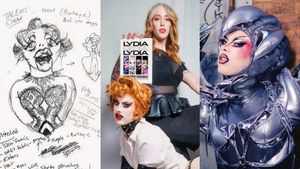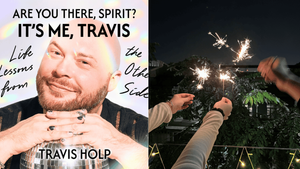Patrisse Cullors bristles at the mention of separate "communities" when discussing her work cofounding the Black Lives Matter movement and fighting to abolish America's prison-industrial complex.
"The queer community is the black community, and the black community is the queer community, because we exist in both communities," she explains. "There's no way they could be separate communities, because I'm black and queer. I don't live in two different places -- I live in both places. I live in the queer community, I live in the black community, and I believe they are one in the same. "
But she's also quick to note that simultaneous membership in multiple communities does not mean everyone's experience of marginalization is the same.
"What I don't want to do is conflate our struggles, because they're different, because we have different histories," she says. "What I find most interesting, though, is when we're able to have a conversation about the intersections."
Cullors, a 32-year-old black queer cisgender woman, has created her life's work at those intersections. In addition to her founding role in Black Lives Matter, she founded Dignity and Power Now in 2012, a Los Angeles-based organization that "fights for the dignity and power of incarcerated people, their families, and communities," according to the group's website. She also serves as the director of truth and reinvestment at the Ella Baker Center for Human Rights and is an accomplished performance artist who earned her degree in religion and philosophy from the University of California, Los Angeles.
Despite her longtime intersectional approach to activism, Cullors still sees well-intentioned people confounded by the idea that the struggles of marginalized people are interconnected.
"People ask me, 'Well, why do you choose to say you're queer? Why don't you just say you're black?'" she recounts. "And I say, 'Because I'm not just black. I am all the things that have been able to make up this current movement.'"
Acknowledging and creating space for the multitudes contained in every person is critical to the success of that movement, Cullors explains. Black Lives Matter would not be what it is today if it had not been founded by three black women, two of whom identify as queer.
"[Black Lives Mattter] was created from not just a politic of 'blackness,' but it was created from the intersections of blackness, womanness, and queerness," she explains.
The conversations that Black Lives Matter activists nationwide have been able to facilitate with politicians, pundits, and even police precincts might not have happened if the movement was borne out of a singular focus. But because racial profiling, police brutality, and chronic criminalization affect so many Americans, the movement in which Cullors works is necessarily multifaceted.
While many of her Black Lives Matter contemporaries focus on police brutality and vigilante violence against black people, Cullors focuses her work on the outcome of violent policing of black and brown bodies that doesn't end in death. She believes the American criminal justice system is inherently unjust, and biased against minorities, and she has long worked to dismantle the entire system.
"Jails and prisons are no place for any human being, and in my opinion, should be abolished," she says. "The way in which we understand punishment in this country is barbaric and brutal."
The impact of that brutality is worse for marginalized communities, she argues, including LGBT people, women, and people of color. Pew Research reports that black men were six times more likely than white men to be incarcerated, according to statistics available in 2010. That disparity is actually worse than it was in 1960, before passage of the Civil Rights Act.
The disparity is even more stark, according to a 2014 University of Chicago study, when factoring in education level. Black men without a high school education are being locked up at incredibly high rates that far outpace that of their white counterparts, suggesting that the circumstances that put people in jail actually start long before the courtroom. For these individuals, already disadvantaged on an educational level, any length of jail time (even for a nonviolent drug offense) substantially reduces the chances of getting a good job after serving their supposed "debt to society," even with access to overburdened rehabilitation programs.
Cullors highlights that rehabilitation programs for incarcerated individuals skew heavily toward cisgender men, which too often leaves women and LGBT people in jail without basic support offered other inmates.
"The reality is that black women have some of the highest incarceration rates amongst our communities," she explains. "I think there's a significant amount of LGBTQ folks who are inside jails and prisons who are not receiving the care and the support that is necessary and that is needed."
Data backs up Cullors's assessment. While the total U.S. prison population -- of all genders -- increased markedly since 1980, the number of women in prison increased at nearly 1.5 times the rate of men between 1980 and 2010, according to The Sentencing Project. The American Civil Liberties Union reports that between 1995 and 2005, the women's prison population grew at a steady 4.5 percent annually, to today's reality where 7 percent of the nation's incarcerated individuals are women.
Among those women incarcerated, the vast majority are black or Latino. In her lifetime, a U.S.-born woman who happens to be black has a one in 18 likelihood of being imprisoned, while a Latina's likelihood of ending up incarcerated is one in 45, according to The Sentencing Project. White women's lifetime likelihood of being imprisoned is one in 111. Women are also more likely than their male counterparts to have school-age children at home while they are incarcerated, meaning their imprisonment can have especially potent ripple effects through a family.
Add that grim reality to the fact that there are countless transgender people currently incarcerated -- usually in facilities at odds with their gender expression -- and often denied health care deemed medically necessary or placed in solitary confinement as a "protective" measure, and Cullors's driving mantra becomes crystal clear.
"We're talking about someone being a whole human being," says Cullors when asked why her activism focuses on the multifaceted identities one individual can hold. "When you are walking down the street and you look at someone, you don't just look at their race. You look at everything that they are. The first impression, their perceived gender, what color hair they have, their perceived racial identity. We see all those things at once -- we don't see them as separate things. ... We have to represent people as their entire selves."
CORRECTION: An earlier version of this article misstated Cullors's age. She is 32, and copy above has been edited to reflect this change.





































































Charlie Kirk DID say stoning gay people was the 'perfect law' — and these other heinous quotes